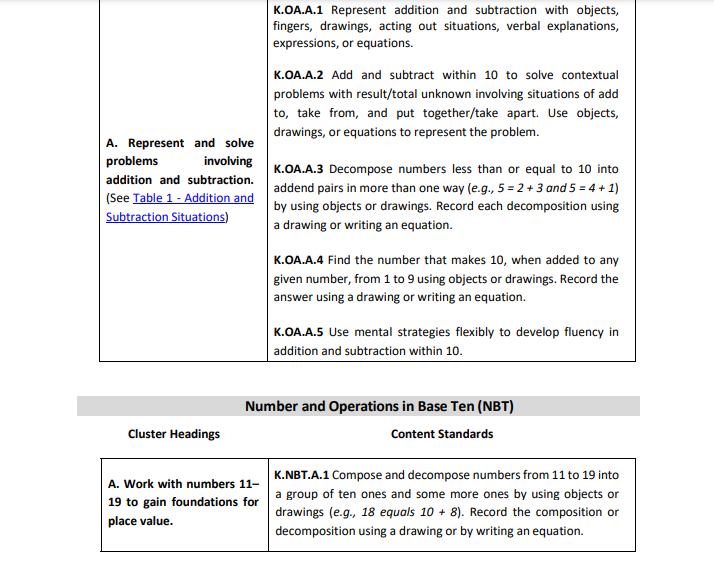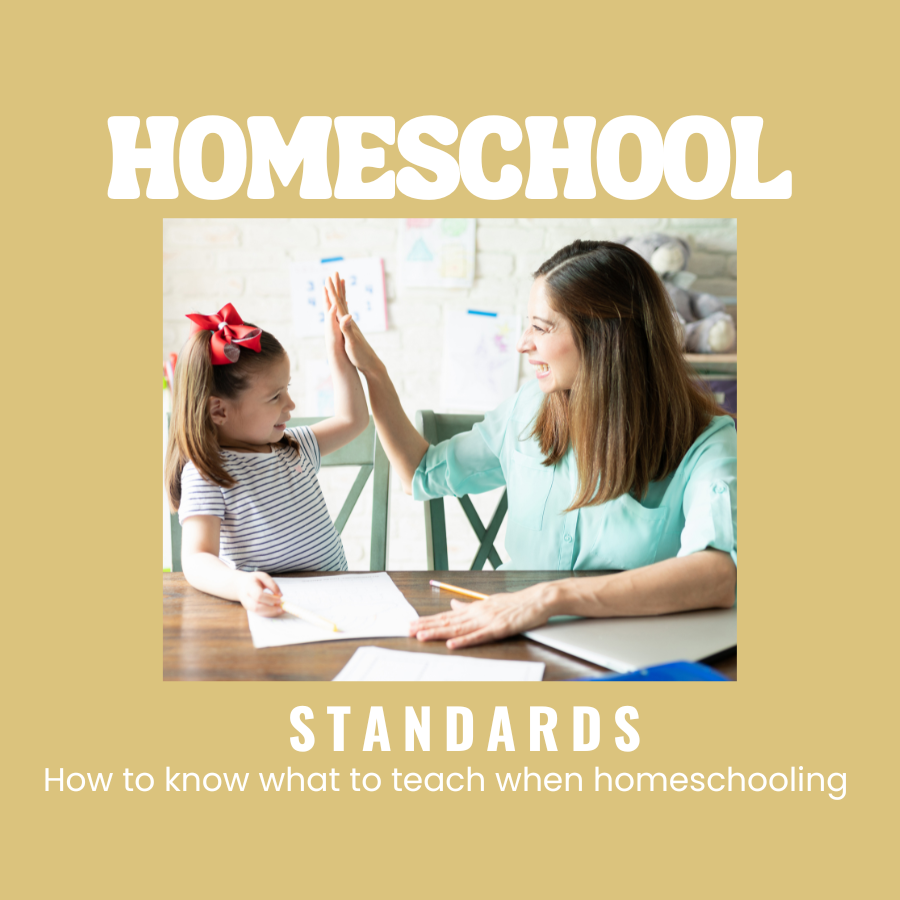This is a question I hear a lot from first time homeschool parents. You are going to hear a ton of different opinions from different types of homeschoolers. For example, if you talk to an unschooling parent, what the child is going to learn has a lot to do with the child’s interests. If you talk with a Charlotte Mason family, it will be centered around nature and the arts.
I am going to hit you with a more traditional approach but can be totally paired with these homeschool types above!

STANDARDS
Each state will have state standards. This will be a list of things your student “should know” by the end of their grade level for each subject. Just think of it as a guide of what to teach.
So now you know that this list exists, the question is, where do you find it? Most states will generally have the same standards. Because of this, it really doesn’t matter which state you pick but pick a state, and google the standards. We live in Tennessee and I have taught with Tennessee state standards. These are the standards that I am familiar with so these are the ones I use.
What I have noticed, is some are easier to read than others. If your states standards are confusing, pick another state. Once again, it is okay to pick another state. I will be happy to answer any and all questions about standards that are confusing or if you are just wondering why they are included.
To find my state standards, I simply type Tennessee state standards in google. I am attaching an example of some of our Tennessee sate standards, so you can see an example. The Tennessee state standards are broken up into subjects, ELA, Math, Science, and Social Studies. There are also others, such as Music, Art, P.E., and Bible (for older students), ect.
Each subject is broken into sections. For example, ELA is broken into Foundational Literacy, Reading, Speaking and Listening, and Writing.
The number/letter combos at the beginning of the standard has meaning but not necessarily needed for homeschool. I can totally share what all of it means, if wanted.
These standards seem a little hard to understand but I will give you some tips on how to understand what they mean later on!

If you look at this standard, you will see kindergarten and first grade standards for sentence composition.
If you look at the kinder standard i, you will see it states kinder students should be able to recognize and name end punctuation. In first, standard k, they should be able to end sentences with correct punctuation. You can see that in kinder, they just have to know end punctuation but in first they have to produce end punctuation.
One thing I love about about the ELA standards is that all K-12 standards are together so you can see how they progress over the years. The main reason that I am such an advocate in following the standards is because it sets you up for success when it comes to college. I KNOW, I KNOW! “Your child might not want to go to college. He is going in the trades like his daddy.” I KNOW, I KNOW! “You are raising an entrepreneur.” I KNOW, I KNOW! “Your child is in kindergarten, you aren’t even thinking about college yet, they are only 5.” Trust me, I am with you 100 percent. I know it doesn’t sound like it, but I really am! I really hope that my daughter decides that she doesn’t want to go to college. College, in my opinion, is a waste of time (in most cases). I think most everyone who has a degree can agree that they learned how to effectively do their job when they entered in work force, not in the lecture hall. Hopefully by the time our children are grown, employers realize this. But in the meantime, college is required for some workforces. My goal in homeschooling my child is to prepare them for the future. Because she is in kindergarten, I am not sure what God will call her to do. My goal is to prepare her for all, whether it is a stay at home mom, a doctor, or an entrepreneur. The good thing is, even if you teach your child to write a paper using MLA citations and she decides she wants to stay at home and raise her family, it isn’t going to handicap her.
Now I know what many of homeschooling parents are thinking, “but I left public school because I didn’t like what they were teaching”. Or, “I think students should be learning more life skills”. You may even be thinking, “my student is below or higher than what the state recommends”. Know that I have thought all of these thoughts and still follow state standards. Repeat after me, “I CAN TEACH ADDITIONAL STANDARDS! I CAN TAKE SOME STANDARDS OUT.” Let me be clear, you should not change half of the standards, but you can omit a few. For example, telling time on an analog clock is not something that I will explicitly teach. Does that mean that I am going to cover her eyes every time we pass by an analog clock or refuse to tell her what the hands on a clock mean if she ask, not at all. It just means I am not going to waste my instructional time working on telling time on a analog clock. Instead, I will spend extra time on elapsed time, because in my experience, students really struggle with this concept.
Now I know what some of you are thinking, ARE YOU KIDDING ME, THAT IS A SKILL KIDS HAVE TO KNOW. That is the beauty of homeschooling! We can teach different things, and IT IS OKAY! When I look around the only analog clock I see is at my parents house. When my daughter is 20, I truly believe those will be few and far between. Just because I decide to not teach a few standards, doesn’t mean I have to throw out ALL standards.
I hear people say, “I left public school because they don’t teach enough life skills!” I agree! A schools job is to prepare children for the real world. It is hard to be prepared for the real world when you don’t know how to do taxes, create a budget, or follow/enhance a recipe. This is why homeschooling is the best! We are blessed to be able to teach our students how to grow our own food AND teach them how to write a 5 paragraph essay comparing and contrasting two different texts. YOU CAN DO BOTH!
This is an example of the Tennessee math standards for kindergarten. These standards do not have the K-12 standards together BUT that does not mean they don’t progress over time. All standards build upon each other.
Once again you see the letter/number combinations at the beginning of the standards. They are not necessary for homeschool, but would love to explain it, if you are interested.

These standards are broken up in sections: Counting and Cardinality, Operations and Algebraic Thinking, Number and Operations in Base Ten, Measurement and Data, and Geometry.
Math standards are a little easier to understand than ELA, but I will share some tips to help you understand later on.
HOW TO UNDERSTAND STANDARDS
At the beginning and end of the standards there is an extensive guide on how to read and understand the standards, but I want to give you a quick overview. You should totally check it out when you have the time because they will give you definitions on some things you might not have learned or need a refresher on for example: cvc words, affix, or clauses.
Below I will explain how I look at and understand these standards. I will take a ELA third grade standard.

When I look at this standard, the first thing I do is look at the the top section. I disregard the a-e for now. These are all separate standards and shouldn’t be taught all at one time.
“Write narratives to develop real or imagined experiences or events using an effective technique, such as descriptive details and clear event sequences.”
Wow, that is a lot of words thrown into one sentence.
Before I start planning my lesson, I make sure that I know my verbs. These are what I want my students to be able to do. When you take grades, this is what you will use. When I look through this standard, I see the verbs write, develop, and using. When I break this down, I want students to
WRITE: narratives
DEVELOP: real or imagined experiences (it is up to you which experience fit your lesson best)
USE: descriptive details and clear event sequences.
I don’t know about you, but when I break it down into verbs, it really helps me understand what I need my child to do.
Write narrative: Now there are some words in here that you might not know exactly what they mean. If, I hadn’t taught, I wouldn’t know what a narrative was or how to teach it. This is where a quick google search will come in handy. “A narrative essay’s purpose is to tell a story. It’s all about sharing an experience or event and is different from other types of essays because it’s more focused on how the event made you feel or what you learned from it, rather than just presenting facts or an argument.”
Now you know what a narrative is, lets discuss the “Develop“. The standard says you must develop an essay that is from real life experience or made up. They are leaving it up to you to decide which one. My recommendation is throughout the year, you should do both.
Use descriptive details and clear event sequences. Now when I read this part, I think cool, but how do I do this? This could mean a lot of different things to different people. This is where a-e come in.
a. Establish a situation by using a narrator, including characters, and organizing an
event sequence that unfolds naturally.
b. Use dialogue and/or descriptions of actions, thoughts, and feelings to develop
experiences and events, or to show the response of characters to situations.
c. Use temporal words and phrases to signal event order.
d. Provide a sense of closure.
e. Apply language standards addressed in the Foundational Literacy standards.
This is how you use descriptive details:
-a.Establish a situation by using a narrator, including characters
-b.Use dialogue and/or descriptions of actions, thoughts, and feelings to develop
experiences and events, or to show the response of characters to situations.
This is how you use clear event sequences:
-a.organizing an event sequence that unfolds naturally.
-c.Use temporal words and phrases to signal event order.
-d.Provide a sense of closure.
e. Apply language standards addressed in the Foundational Literacy standards. (These are standards that basically mean, make sure it makes sense, has punctuation, capital letters, complete sentences ect.)
All these standards SHOULD not be taught at the same time. Remember, students should know this by the end of the year. Take one of these standards and focus on it. Model to students how to use temporal words and focus only on that when writing the narrative that time.
Reading and understand standards take a little practice but once you understand how they are laid out, it will come more naturally.
In the meantime, you can find break downs of the standards on Teachers Pay Teachers that put in a more reader friendly way. Here is an example of the kindergarten one I have.
Please let me know if you have any comments, questions, or concerns below. I would love to help!

Leave a Reply